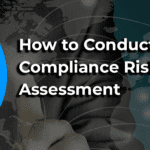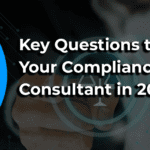
How to Conduct a Compliance Risk Assessment
December 16, 2024
Key Questions to Ask Your Compliance Consultant in 2025
December 20, 2024The regulatory landscape is continuously evolving, with 2025 set to introduce significant changes that will impact businesses across industries. Proactive preparation is essential for staying compliant, avoiding penalties, and maintaining a competitive edge. Here are actionable steps to help your organization prepare for the 2025 Regulatory Changes
1. Stay Informed About Upcoming 2025 Regulatory Changes
The first step in preparation is understanding what’s on the horizon. Key actions include:
- Monitoring regulatory updates: Subscribe to industry newsletters, attend webinars, and follow updates from regulatory authorities such as the Hong Kong Monetary Authority (HKMA).
- Engaging with compliance experts: Collaborate with consultants or legal advisors who specialize in your sector.
- Participating in industry forums: Join discussions to gain insights into how peers are preparing for new regulations.
2. Conduct a Compliance Gap Analysis
A compliance gap analysis helps identify areas where your organization may fall short under the new regulations. Steps include:
- Reviewing current policies and procedures: Ensure they align with upcoming requirements.
- Assessing operational readiness: Identify resources, tools, and training needs to bridge gaps.
- Prioritizing high-risk areas: Focus on compliance areas with the most significant impact on your business.
3. Leverage Technology for Compliance
Regulatory compliance often involves complex processes and extensive documentation. Technology can simplify these tasks:
- Implement compliance management software: Automate monitoring, reporting, and auditing.
- Adopt AI-driven tools: Use artificial intelligence for risk assessment and anomaly detection.
- Utilize blockchain for transparency: Enhance data traceability and accountability in compliance processes. Learn more about RegTech solutions.
Read More on: A Guide to Crypto License in Hong Kong: Fees and Ongoing Compliance
4. Train Your Team
Employees play a critical role in maintaining compliance. Ensure they are well-prepared:
- Provide regular training: Offer workshops and e-learning programs tailored to new regulations.
- Encourage a compliance-first culture: Emphasize the importance of adherence to regulations in daily operations.
- Appoint compliance champions: Designate individuals within departments to act as compliance liaisons.
5. Strengthen Data Privacy Measures
Data privacy continues to be a top regulatory focus worldwide. Preparing for 2025 means:
- Updating data protection policies: Align with new regulations such as expanded GDPR-like laws.
- Enhancing cybersecurity frameworks: Protect sensitive data with advanced security measures.
- Performing regular audits: Ensure compliance with both existing and emerging data privacy requirements. Learn more about data privacy best practices.
6. Monitor Geopolitical and Economic Developments
Geopolitical shifts can significantly impact regulatory requirements. Stay ahead by:
- Tracking global trade policies: Adapt to 2025 Regulatory Changes in import/export regulations and sanctions.
- Assessing supply chain compliance: Ensure suppliers and partners meet regulatory standards.
- Consulting with experts: Engage geopolitical analysts to understand potential impacts on your operations.
7. Collaborate with Industry Peers
Collaboration can provide valuable insights and resources for compliance:
- Join industry associations: Leverage collective knowledge and resources.
- Participate in compliance workshops: Gain actionable advice from industry leaders.
- Share best practices: Collaborate on strategies to navigate complex regulations.
8. Engage with Regulators
Building a relationship with regulatory bodies can ease the transition:
- Seek clarification on new rules: Address ambiguities before regulations take effect.
- Participate in consultations: Provide feedback to regulators during the drafting process.
- Maintain open communication: Foster transparency and goodwill with regulatory agencies.
9. Develop a Contingency Plan
Preparation includes planning for unforeseen challenges:
- Identify potential risks: Anticipate scenarios that could disrupt compliance efforts.
- Establish response protocols: Develop clear steps for addressing non-compliance incidents.
- Allocate resources for adjustments: Ensure the flexibility to adapt quickly to new requirements.
10. Partner with Compliance Experts
Navigating regulatory changes can be complex. Partnering with experts ensures you’re well-equipped to adapt:
- Consult with Paycompliance: Our team specializes in regulatory compliance, licensing, and corporate solutions.
- Access tailored support: Receive customized guidance for your industry and region.
- Leverage global expertise: Benefit from insights into international compliance trends. Contact Paycompliance to learn more.
Final Thoughts
Preparing for 2025 Regulatory Changes requires a proactive and strategic approach. By staying informed, leveraging technology, and fostering a culture of compliance, your organization can navigate the complexities of new regulations with confidence.
At Paycompliance, we’re here to support your compliance journey. Contact us today to learn how we can help you stay ahead of the curve in 2025 and beyond.



